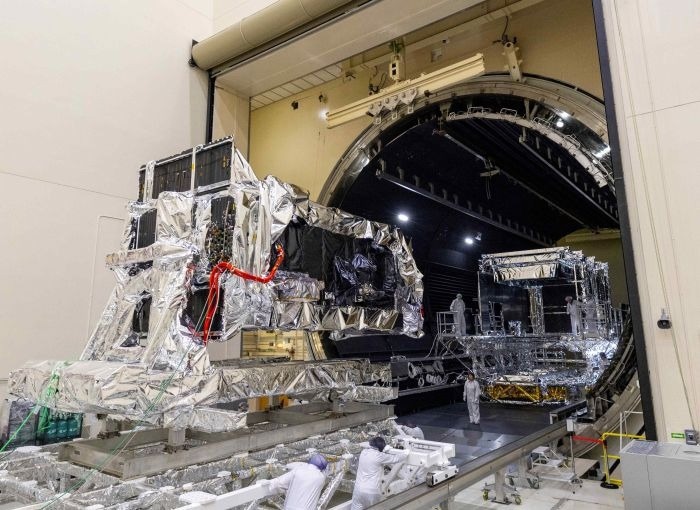The first of a new, more capable, more survivable missile warning satellite, designed by Lockheed Martin for today’s highly contested space domain, has successfully completed environmental testing.

Image Credit: Lockheed Martin
The first Next-Generation Overhead Persistent Infrared (Next-Gen OPIR) Geosynchronous Earth Orbit (GEO) Block 0 missile warning satellite recently completed thermal vacuum (TVAC) and acoustic testing. Completion of both tests, performed at Lockheed Martin Space’s facility in Sunnyvale, California, keeps the satellite on track for delivery.
During TVAC testing, the Next-Gen OPIR GEO satellite faced a grueling, simulated space environment, proving it can operate in and withstand the harsh temperatures and pressures of an extended life in GEO. In acoustic testing, the satellite successfully withstood the violent vibration conditions that it will endure during launch.
With environmental testing complete, the satellite is now in final systems integration testing, which includes testing connections with various ground systems.
“Next-Gen OPIR GEO will enhance America’s persistent, around the clock, global surveillance and detection of missile threats,” said Joe Rickers, vice president of Transport, Tracking & Warning Programs at Lockheed Martin. “With the first Next-Gen OPIR GEO available to launch in the near future, Lockheed Martin is ready to support the government’s mission to protect America.”
Why it Matters: Growing Missile Threats
From a GEO vantage point – approximately 22,000 miles from the Earth’s surface – Next-Gen OPIR GEO’s advanced sensors will have an unmatched view of our planet’s mid-latitudes to detect ballistic missiles, hypersonics and other threats to America and its allies.
Next-Gen OPIR GEO’s new sensors are designed to detect advancing adversary threats, including missile boost technologies that are faster burning and dimmer. The satellites, built on Lockheed Martin’s proven LM 2100™ combat bus, include resiliency features to address counter-space threats.
The pacesetting Next-Gen OPIR GEO program will enhance and eventually succeed the on-orbit, Lockheed Martin-developed Space Based Infrared System (SBIRS). SBIRS is a combat-proven, space-based early warning system that has protected America’s troops and allies from ballistic missile attacks.
In 2024, SBIRS provided timely detection and early warning of hundreds of missiles launched at Israel, allowing the U.S. and its allies to track and intercept the threats. In 2020, SBIRS protected U.S. forces at Al-Asad Airbase, in Iraq, from a ballistic missile attack.
Contributing to a Layered Homeland Defense
“America’s best defense is always going to start with having the earliest possible warning of threats – and that warning comes from what we see in space,” said Jeff Schrader, vice president for Strategy and Business Development at Lockheed Martin. “Building off our established mission experience, Next-Gen OPIR GEO will provide timely, critical missile warning data to inform our nation’s layered missile defense systems.”
The new Next-Gen OPIR GEO satellites will work in tandem with SBIRS and future Next-Gen OPIR Polar satellites. These systems will integrate into a seamless, resilient, multi-layered national missile warning, tracking and defense architecture.